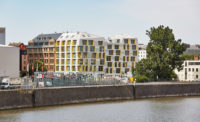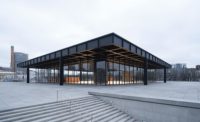In 2014, when a through-floor duplex on the 15th and 16th levels of the Corbusierhaus in Berlin was offered to Stuttgartbased architect Joerg Aldinger, a fan of Le Corbusier, he purchased the unit sight unseen. But, although the block stands in a leafy, low-rise neighborhood roughly eight miles from the city center, Aldinger’s first visit to his unit was a letdown. Unlike the double-height apartments in the first Unité d’Habitation in Marseille, all of the studio and duplex residences in the Berlin version are single-height—a strategy adopted to maximize rentable space when the block was built in 1957. Moreover, this apartment’s previous owner had decorated with shrill colors and sharply-angled built-ins. Spatial complexity, careful proportions, and rich materials were nowhere to be seen.
The transformation of the 1,190-square-foot duplex into a weekend getaway for himself, his wife, and their 8-year-old son was difficult, says Aldinger. “Because Le Corbusier is such an Übervater [a dominant father figure], you always feel he is looking over your shoulder.” So instead of imposing another design philosophy, Aldinger selectively applied ideas from the Swiss-born master’s work to fashion an atmosphere that would suit its provenance.
To lend the 13-foot-wide unit a feeling of spaciousness, Aldinger embraced a plan libre. He ripped out partitions, removed the wall enclosing the staircase, and exposed the ceiling beams on the lower level. He then used matte slategray sliding panels to define a bedroom east of the stairs and, on the level above, enclose a small entry vestibule opening onto the kitchen/dining area.
The architect devised strategies to draw attention to the city views unfolding via Corbusier’s articulated elevations. On the 16th floor, a recessed exhaust vent in the stainlesssteel surface of the kitchen island keeps the ceiling unobstructed and preserves the clear vista of downtown Berlin. On the 15th floor, a bathroom, half bath, laundry, and a sleeping niche occupy a 4-foot-deep band hugging the south wall. This compact arrangement frees up the 65-foot-long space between the eastern and western facades and directs one’s gaze to the panoramas unfolding beyond.
To evoke the warmth of béton brut concrete, Aldinger selected a muted palette from Corbusier’s polychromie architecturale. The north wall of the apartment features a soft Zürich white, while dark and light shades of terre d’ombre appear on the south, and flint-gray linoleum covers the floor. Other finishes include taupe-toned mosaic bathroom walls, not unlike those on Villa’s Savoye’s iconic reclining bath, and a satiny black steel stair structure and handrail.
The most surprising aspect of this interior is its ability to highlight the daily rhythms of the city. The darker and cooler palette found on the eastern ends complements both the freshness of the sunrise and the views of Berlin’s nighttime skyline. Softer and warmer tones appear on the lower level’s west end, and they harmonize with the late-afternoon sun as it floods the interior or bathes the sprawling western suburbs in a fiery light.
Against the backdrop of these gentle hues, it is the carefully placed traces of everyday life, some prosaic, others less common—dining room chairs by Harry Bertoia and Jean Prouvé, a vintage semi-electric acoustic Pevey jazz guitar on a stand, a child’s possessions, or crockery arranged in the built-in black-stained MDF-panel shelving—that keeps the spirit of LeCorbusier most in place.
Completed in 2016, the renovation has given Aldinger a new perspective on Le Corbusier’s architecture. “He has become part of my daily life,” he says. “Now I feel he was just another architect—although quite a bit better than the rest.”
CreditsArchitect: Aldinger Architekten Planungsgesellschaft mbH Freie Architekten BDA Grosse Falterstrasse 23 a, 70597 Stuttgart Phone +49 711 97678-0 www.aldingerarchitekten.de
Personnel in architect's firm who should receive special credit: Prof. Jörg Aldinger
Photographer: Roland Halbe
|
SpecificationsGlazing Glass railing: System Crosilux
Doors Sliding doors: Tischlerei Krafft
Hardware FSB
Interior Finishes Floor and wall tile: Bisazza Resilient flooring: Linoleum, Forbo
Furnishings Chairs: Vitra Tables: Cassina Other furniture: Neue Tische, Berlin
Lighting Interior ambient lighting: Flos Downlights: Osram Linestra
Plumbing Fittings: KWC Sinks: Duravit Shower: Duravit |



















